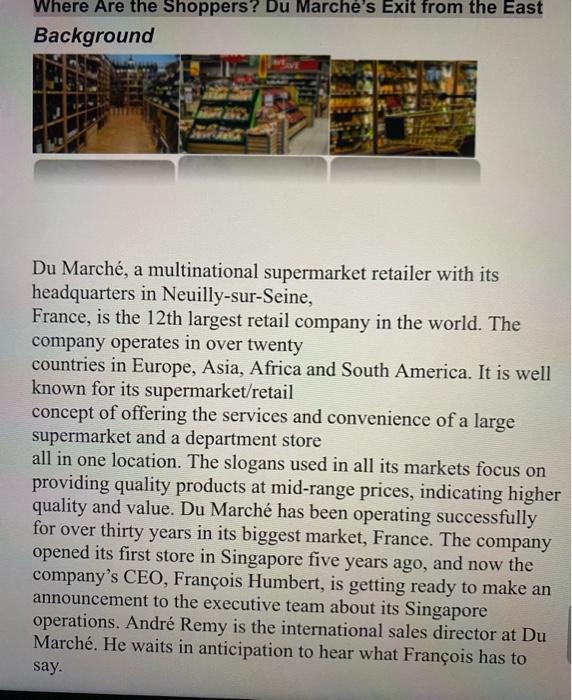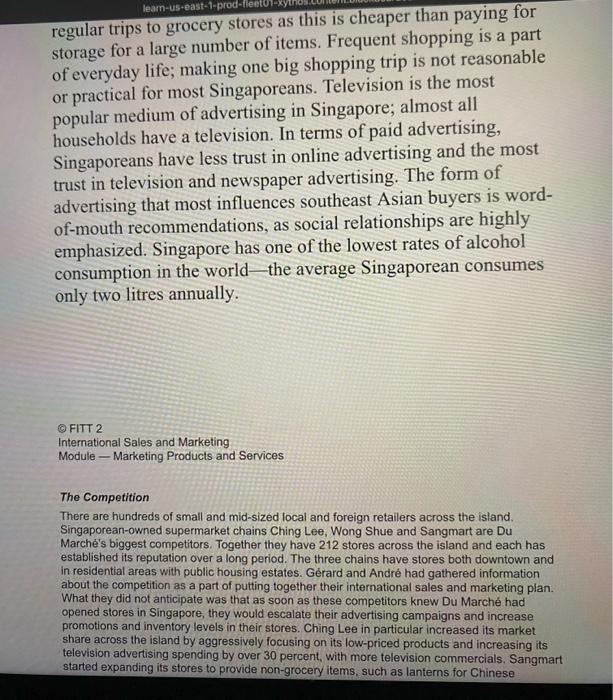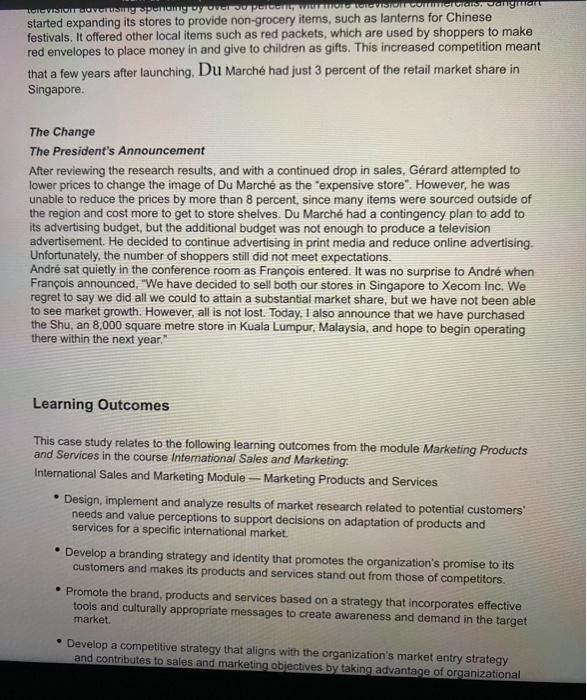Where Are the Shoppers? Du Marche's Exit from the East Background Du March, a multinational supermarket retailer with its headquarters in Neuilly-sur-Seine, France, is the 12th largest retail company in the world. The company operates in over twenty countries in Europe, Asia, Africa and South America. It is well known for its supermarket/retail concept of offering the services and convenience of a large supermarket and a department store all in one location. The slogans used in all its markets focus on providing quality products at mid-range prices, indicating higher quality and value. Du March has been operating successfully for over thirty years in its biggest market, France. The company opened its first store in Singapore five years ago, and now the company's CEO, Franois Humbert, is getting ready to make an announcement to the executive team about its Singapore operations. Andr Remy is the international sales director at Du March. He waits in anticipation to hear what Franois has to say. The Singapore Story Several years ago, Franois set his eyes on Singapore to introduce the Du March shopping experience to the Asian market. With a smaller population and area than most Asian countries, Singapore seemed a less risky market in which to launch. Du March would be the first retail group to offer a collection of store-branded French clothing, home products and groceries all under one roof. The goal was to become the market leader in Singapore, with at least 30 percent market share. In the downtown business district, there were two leaseholds available for facilities that would fit the "shop in one place" retail concept. The rent was more than expected, but fair given the facilities were centrally located and big enough to maintain Du Marche's traditional large-sized stores. Franois hoped that much like shoppers in large American and European cities, the Singapore consumer would see the value and convenience of having a weekly trip to Du March over shopping several times a week, in multiple locations, for a smaller number of items. Andr appointed BMD, an international marketing agency, to develop the company's advertising campaign in Singapore. BMD created print ads for magazines and newspapers, as well as online display advertising. Andr decided to spend the advertising budget on website advertising and print ads rather than on television commercials. All advertisements would be in English and Mandarin. Grard Lvy, the president of Du March Singapore, and his corporate executive team hired local sales associates for the stores, while the management teams to run the stores were all from Du Marche's head office in France. This was their first store in Asia and they wanted to have complete control over its operations. They sourced 40 percent of the products from the region and the remainder from other countries, mainly France and the U.S. They believed the average Singaporean would rather shop in spacious, air conditioned stores offering higher quality products than in local stores which had limited selections and smaller aisles. When Du March opened its two stores, the all-in-one retail concept was successful and the number of shoppers who came to the stores was record breaking. During the following months, however, the number of shoppers declined steadily and revenue fell. Investigations revealed that most customers who now shopped at the stores were first-time buyers. Du March was not getting the expected number of repeat shoppers. The company had an aggressive web-based advertising campaign, and the print ads showed several high-quality items. Andr believed that Du March's items were priced fairly at only 15 to 20 percent higher than similar products. As shoppers could get many household items without travelling to multiple stores, why would they want to go anywhere else? The store even offered a wide selection of affordably priced wines, but the sales were very low. After the number of shoppers continued to drop for about six months. Grard hired a team of market researchers to conduct a survey amongst random shoppers could get many household items without travelling to multiple stores, why would they want to go anywhere else? The store even offered a wide selection of affordably priced wines, but the sales were very low. After the number of shoppers continued to drop for about six months, Grard hired a team of market researchers to conduct a survey amongst random shoppers who did not shop at Du March. After careful investigation and research, Grard received a full report that highlighted a few key points. The report is best summarized in a comment made by Xing Fang, an average shopper who frequently shops at a competitor's store: "I don't know too much about Du March. I think it mostly sells French perfume and cheese. I would go to look at the store, but I am not sure I could afford anything. Besides, the stores are too far away. Nobody lives around there. I work downtown, but I am not going to go there to buy my groceries; my grocery store is just next to my apartment. If I want nice things, I will cross the Causeway to go to Malaysia, where the exchange rate gives me more for my money. There are good bargains there." Additional market research also showed some significant details about the market and the company's competition that seemed to have been missed. The Market Singapore is an island city-state that is one of the three most densely populated countries in the world. Singapore's downtown area has high traffic congestion and high parking rates. Singaporeans are multiracial and multicultural people. Over 25 percent of the country's residents were born overseas. There are four official languages in Singapore: Malay, Mandarin, Tamil and English. Approximately 30 percent of Singaporeans speak English; the majority of the population speaks a blend of English and one of the official languages. Land is scarce and most people live in subsidized high-rise public housing apartments on what are known as public housing estates. Over 75 percent of resident households live in an apartment with four rooms. As space is precious, people do not usually store unused items in their homes. Singaporeans are price-conscious people who make regular trips to grocery stores as this is cheaper than paying for regular trips to grocery stores as this is cheaper than paying for storage for a large number of items. Frequent shopping is a part of everyday life; making one big shopping trip is not reasonable or practical for most Singaporeans. Television is the most popular medium of advertising in Singapore; almost all households have a television. In terms of paid advertising, Singaporeans have less trust in online advertising and the most trust in television and newspaper advertising. The form of advertising that most influences southeast Asian buyers is wordof-mouth recommendations, as social relationships are highly emphasized. Singapore has one of the lowest rates of alcohol consumption in the world - the average Singaporean consumes only two litres annually. (0) FITT 2 International Sales and Marketing Module - Marketing Products and Services The Competition There are hundreds of small and mid-sized local and foreign retailers across the island. Singaporean-owned supermarket chains Ching Lee, Wong Shue and Sangmart are Du March's biggest competitors. Together they have 212 stores across the island and each has established its reputation over a long period. The three chains have stores both downtown and in residential areas with public housing estates. Grard and Andr had gathered information about the competition as a part of putting together their international sales and marketing plan. What they did not anticipate was that as soon as these competitors knew Du March had opened stores in Singapore, they would escalate their advertising campaigns and increase promotions and inventory levels in their stores. Ching Lee in particular increased its market share across the island by aggressively focusing on its low-priced products and increasing its television advertising spending by over 30 percent, with more television commercials. Sangmart started expanding its stores to provide non-grocery items, such as lanterns for Chinese started expanding its stores to provide non-grocery items, such as lanterns for Chinese festivals. It offered other local items such as red packets, which are used by shoppers to make red envelopes to place money in and give to children as gifts. This increased competition meant that a few years after launching. Du March had just 3 percent of the retail market share in Singapore. The Change The President's Announcement After reviewing the research results, and with a continued drop in sales, Grard attempted to lower prices to change the image of Du March as the "expensive store". However, he was unable to reduce the prices by more than 8 percent, since many items were sourced outside of the region and cost more to get to store shelves. Du March had a contingency plan to add to its advertising budget, but the additional budget was not enough to produce a television advertisement. He decided to continue advertising in print media and reduce online advertising. Unfortunately, the number of shoppers still did not meet expectations. Andr sat quietly in the conference room as Franois entered. It was no surprise to Andr when Franois announced, "We have decided to sell both our stores in Singapore to Xecom Inc. We regret to say we did all we could to attain a substantial market share, but we have not been able to see market growth. However, all is not lost. Today, 1 also announce that we have purchased the Shu, an 8,000 square metre store in Kuala Lumpur, Malaysia, and hope to begin operating there within the next year," Learning Outcomes This case study relates to the following learning outcomes from the module Marketing Products and Services in the course International Sales and Marketing: International Sales and Marketing Module - Marketing Products and Services - Design, implement and analyze results of market research related to potential customers' needs and value perceptions to support decisions on adaptation of products and services for a specific international market. - Develop a branding strategy and identity that promotes the organization's promise to its customers and makes its products and services stand out from those of competitors. - Promote the brand, products and services based on a strategy that incorporates effective tools and culturally appropriate messages to create awareness and demand in the target market. - Develop a competitive strategy that aligns with the organization's market entry strategy and contributes to sales and marketing objectives by taking advantage of organizational 1. Identify the challenges Du March faced in penetrating the market in Singapore. 2. Based on the challenges Du March had in Singapore, what advice would you offer to Grard before operations begin in Malaysia? 3. What recommendations would you have given to Andr about advertising in Singapore before opening the two stores












